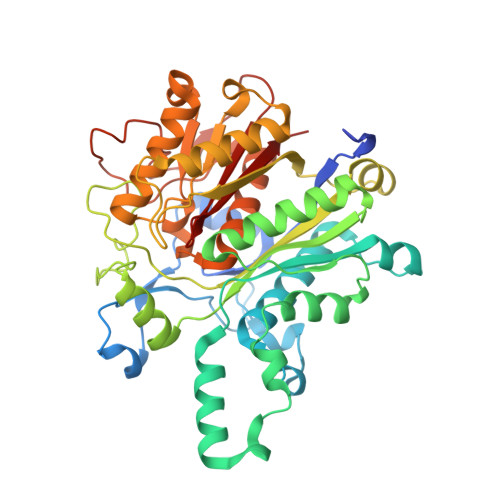Structure of the Human Beta-Ketoacyl [Acp] Synthase from the Mitochondrial Type II Fatty Acid Synthase.
Christensen, C.E., Kragelund, B.B., von Wettstein-Knowles, P., Henriksen, A.(2007) Protein Sci 16: 261-272
- PubMed: 17242430
- DOI: https://doi.org/10.1110/ps.062473707
- Primary Citation of Related Structures:
2IWY, 2IWZ, 2IX4 - PubMed Abstract:
Two distinct ways of organizing fatty acid biosynthesis exist: the multifunctional type I fatty acid synthase (FAS) of mammals, fungi, and lower eukaryotes with activities residing on one or two polypeptides; and the dissociated type II FAS of prokaryotes, plastids, and mitochondria with individual activities encoded by discrete genes. The beta-ketoacyl [ACP] synthase (KAS) moiety of the mitochondrial FAS (mtKAS) is targeted by the antibiotic cerulenin and possibly by the other antibiotics inhibiting prokaryotic KASes: thiolactomycin, platensimycin, and the alpha-methylene butyrolactone, C75. The high degree of structural similarity between mitochondrial and prokaryotic KASes complicates development of novel antibiotics targeting prokaryotic KAS without affecting KAS domains of cytoplasmic FAS. KASes catalyze the C(2) fatty acid elongation reaction using either a Cys-His-His or Cys-His-Asn catalytic triad. Three KASes with different substrate specificities participate in synthesis of the C(16) and C(18) products of prokaryotic FAS. By comparison, mtKAS carries out all elongation reactions in the mitochondria. We present the X-ray crystal structures of the Cys-His-His-containing human mtKAS and its hexanoyl complex plus the hexanoyl complex of the plant mtKAS from Arabidopsis thaliana. The structures explain (1) the bimodal (C(6) and C(10)-C(12)) substrate preferences leading to the C(8) lipoic acid precursor and long chains for the membranes, respectively, and (2) the low cerulenin sensitivity of the human enzyme; and (3) reveal two different potential acyl-binding-pocket extensions. Rearrangements taking place in the active site, including subtle changes in the water network, indicate a change in cooperativity of the active-site histidines upon primer binding.
Organizational Affiliation:
Department of Molecular Biology, University of Copenhagen, DK-2100 Copenhagen, Denmark.
















